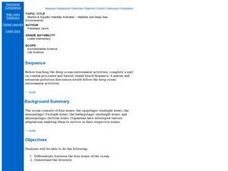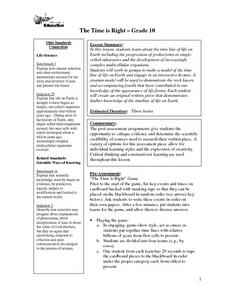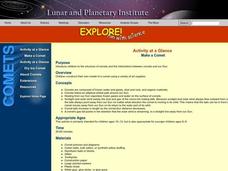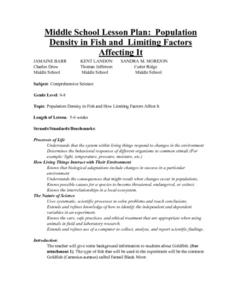Curated OER
Food Chains Are Not A Necklace!
Second graders examine how food chains interact with different plants and animals. They practice using new vocabulary. They also discover the role of pesticides in the environment.
Curated OER
Super Spreadsheets
Learners develop a spreadsheet containing statistical data. They describe and interpret the data to make conclusions. They review the differences between an unorganized spreadsheet verses an organized one.
Curated OER
Oceanography: Understanding the Relationship Among Ocean Food Chains
Fourth graders explore relationships among organisms involved in ocean food chains to investigate interdependence of the organisms.
Curated OER
Habitats and Deep Sea Environments
Students examine and identify the characteristics of the four zones of the ocean. They discover the amount of diversity in marine habitats. They also explore the adaptations organisms have that have allowed them to survive.
Curated OER
The Time is Right
Tenth graders study the timeline of life on Earth. They learn about the progression of prokaryotes to single celled eukaryotes and the development of increasingly complex multicellular organisms.
Curated OER
Make a Comet
Students construct their own model of a comet using a variety of art supplies by reviewing pictures and diagrams of comets. They examine the structure of comets and the interactions between comets and our Sun.
Curated OER
Wrapped in Mystery
Sixth graders can identify five basic elements that most mysteries contain. They put the elements of mystery into a graphic organizer they can follow. They construct meaning after reading Poe's short story and identify or infer the...
Curated OER
Snow Day
Third graders examine the effects of a snow day on various people in the community. They listen to the book "Snow Day" by Betsy Maestro, complete a graphic organizer of people affected by the snow day, and write a story from the point of...
Curated OER
What Color is Chlorophyll?
Students observe the interactions of chlorophyll and light. They develop and form their own testable hypotheses. Students predict the color of chlorophyll in various types of plants.
Curated OER
Mouthpart Madness
Learners explore the basic biology of a pest. They identify the four major kinds of insect mouthparts and explain how they work. Students examine the specific mouthparts and how they can limit food resources and in what environment an...
Curated OER
Plants of the Past
Fourth graders explore ecosystems by examining plants of the past. They discuss ways in which we interact with plants in our daily lives. Students discuss the role plants play in providing food for animals and the significance they had...
Curated OER
Grand Grocery Graphs
Learners experience creating their own graphs on graph paper and the computer program "Graph Club." They approach this task by utilizing food as their primary source for the activities. In addition, they interact with their peers as they...
Curated OER
Earthworm Bridge
Fourth graders complete analysis experiments for decomposers and their adaptable traits. In this decomposers lesson, 4th graders test worm behavior to light, sound, warmth, touch, and moisture. Students work in groups to analyze the...
Curated OER
Personal Timeline
Seventh graders review the stages of the writing process. In this writing process lesson, 7th graders review the writing process steps by creating a personal timeline. Students complete graphic organizers for the lesson and present their...
Curated OER
Country Research
Sixth graders research a given country using teacher selected websites. They gather notes about their country in an organized manner. They then create a PowerPoint including a reference page displaying the information they gathered.
Curated OER
Population Density In Fish
Students investigate how a population of fish multiplies in an ecosystem and the kinds of things that must be done to maintain a healthy population balance with other organisms that live there. They conduct an experiment to test the...
Curated OER
Endocrine System Study Question Worksheet
In this endocrine system worksheet, students define 8 words associated with this human system. They answer 11 short answer questions about the structure and function of the organs and hormones that make up the endocrine system.
Curated OER
Exploring Food Groups
For this food group worksheet, students complete a graphic organizer. Students identify food groups found in each "combination" food.
Curated OER
Ecological Pyramids
Students apply the ecological pyramids of numbers and biomass with an activity using topographic maps. In this trophic level lesson, students work in groups using a topographic map to determine the number of organisms that can live in an...
Curated OER
Explorit's Coffee, Tea or Chocolate Quiz
In this coffee and tea worksheet, students complete a six question multiple choice on-line interactive quiz about the cultivation and chemistry of coffee, tea and chocolate.
Curated OER
Butterfly Metamorphosis
Young scholars read a story, watch a video, and interact with a butterfly website to learn about butterfly metamorphosis. In this butterfly lesson plan, students listen, discuss, and participate in activities relating the metamorphosis...
Curated OER
Animal Masks
Learners design and make animal masks. In this research and application lesson, students use a computer to research what a panther eats, select an animal mask they want to make and then use the materials provided to create their...
Curated OER
Beyond Louisiana
Eleventh graders examine the challenges that faced United States as a new nation. In this American History lesson, 11th graders study the chronology of events leading up to the expedition of Lewis and Clark. Students organize...
Curated OER
Early Explorers
Fifth graders research European explorers. In this world history lesson, 5th graders will compare eight European explorers and identify important factual information about each. Students will be engaged through game-play and...

























